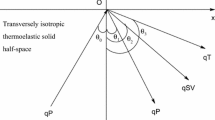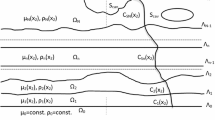Abstract
The 1D electric field and heat-conduction equations are solved for a slab where the dielectric properties vary spatially in the sample. Series solutions to the electric field are obtained for systems where the spatial variation in the dielectric properties can be expressed as polynomials. The series solution is used to obtain electric-field distributions for a binary oil-water system where the dielectric properties are assumed to vary linearly within the sample. Using the finite-element method temperature distributions are computed in a three-phase oil, water and rock system where the dielectric properties vary due to the changing oil saturation in the rock. Temperature distributions predicted using a linear variation in the dielectric properties are compared with those obtained using the exact nonlinear variation.
Similar content being viewed by others
References
F. E. Vermeulen and B. McGee, In situ electromagnetic heating for hydrocarbonrecovery and environmental remediation. J. Canad. Petr. Technol. 39 (2000) 24–28.
M.Y. Soliman, Approximate solutions for flow of oil heated using microwaves. J. Petr. Sci. Eng. 18 (1997) 93–100.
R. E. Collins, Flow of Fluids through Porous Materials. New York: ReinholdPubl. Corp. (1961) 270 pp.
K. G. Ayappa, H. T. Davis, E. A. Davis and J. Gordon, Analysis ofmicrowave heating of materials with temperature dependent properties. AIChE J. 37 (1991) 313–1667.
H. Fricke, The complex conductivity of a suspension of stratified particles of spherical or cylindricalform. J. Phys. Chem. 56 (1955) 168–174.
X. Zeng and A. Faghri, Experimental andnumerical study of microwave thawing heat transfer of food materials. ASME Trans. J. Heat Transfer 116 (1994) 446–455.
K. G. Ayappa, H. T. Davis, G. Crapiste, E. A. Davis and J. Gordon,Microwave heating: An evaluation of power formulations. Chem. Eng. Sci. 46 (1991) 1005–1016.
E. D. Rainville, Elementary Differential Equations. New York: Macmillan (1965) 521 pp.
T. Basak and K. G. Ayappa, Analysis of microwave thawing of slabs with effective heat capacity method. AIChE J. 43 (1997) 1662–1667.
S. A. Barringer, K. G. Ayappa, J. Gordon, E. A. Davisand H. T. Davis, Power absorption during microwave heating of emulsions and layered systems. J. Food Sci. 60 (1995) 1132–1136.
C. M. Bender and S. A. Orszag, Advanced Mathematical Methods forScientists and Engineers. New York: Mc-Graw Hill (1984) 593 pp.
C. A. Balanis, AdvancedEngineering Electromagnetics. New York: John Wiley & Sons (1989) 981 pp.
Author information
Authors and Affiliations
Rights and permissions
About this article
Cite this article
Ayappa, K., SenGupta, T. Microwave heating in multiphase systems: evaluation of series solutions. Journal of Engineering Mathematics 44, 155–171 (2002). https://doi.org/10.1023/A:1020859312712
Issue Date:
DOI: https://doi.org/10.1023/A:1020859312712




